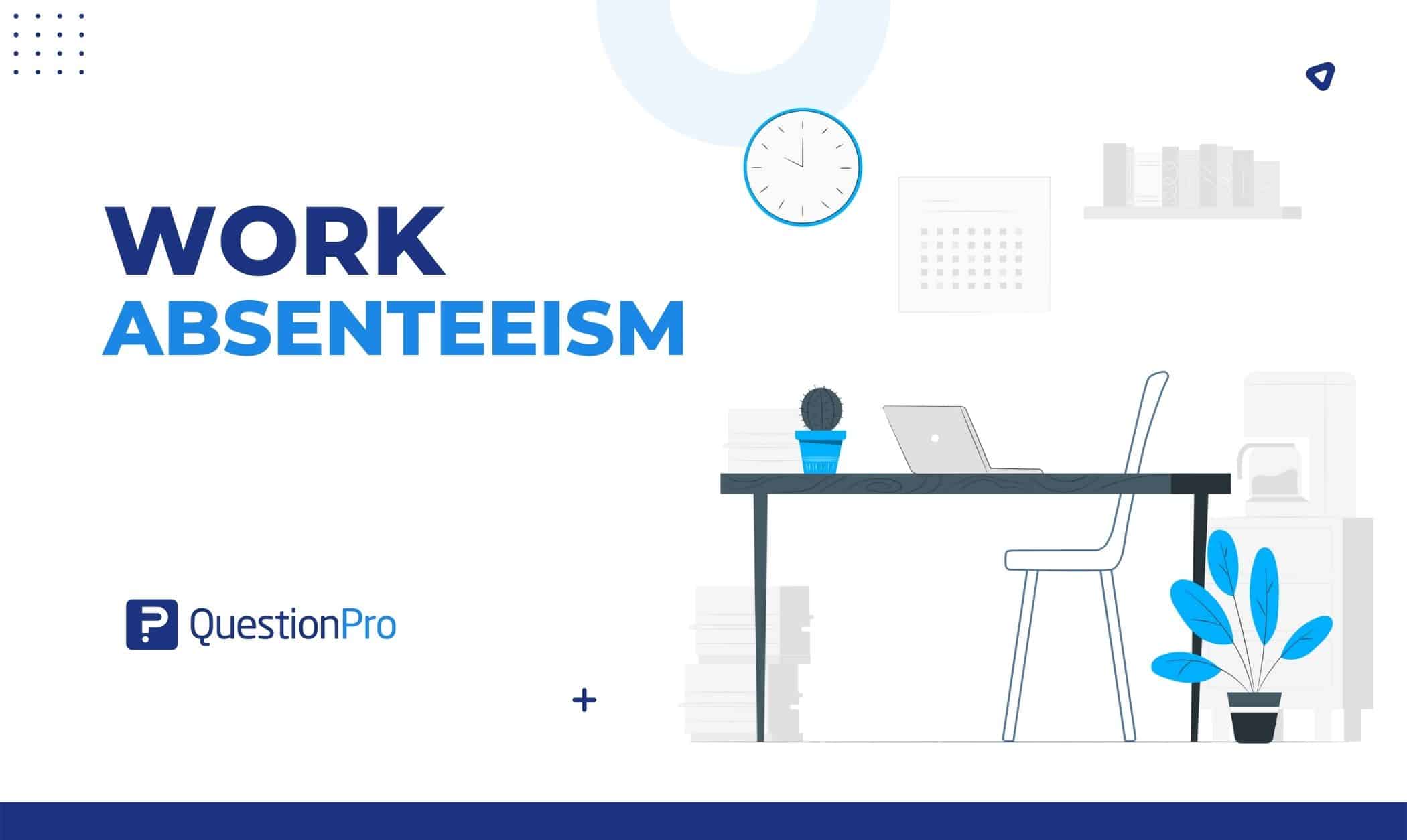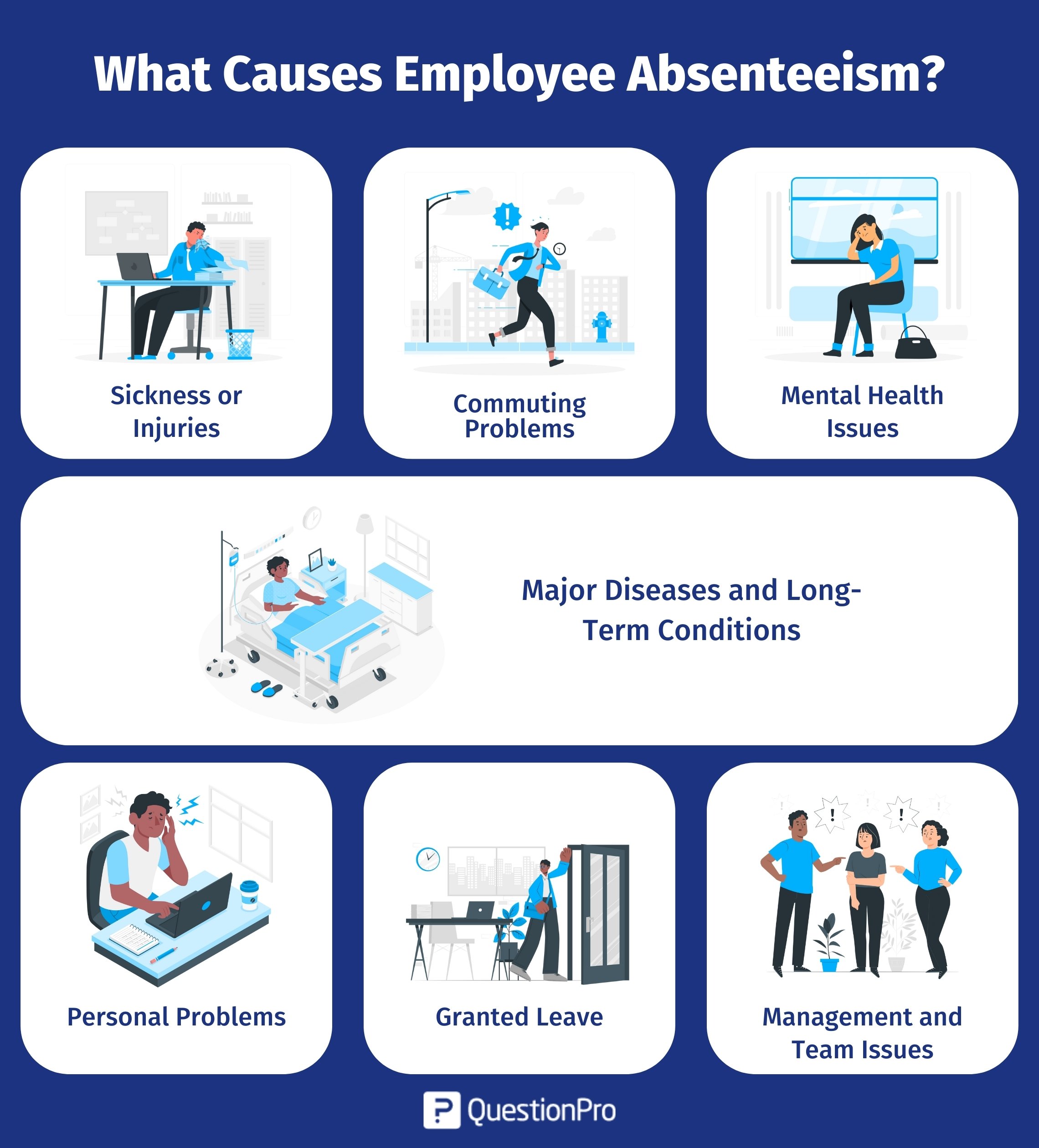
To understand work absenteeism, we should first understand what it means to be absent. Absence at work is a time or event when you are not at work. People aren’t at work because they are sick, sick from workplace stress, or for other reasons.
Employee absences may not seem to be a big deal at first look. After all, crises do arise. Finding one or two empty chairs in your company is common for you as an HR staff or a manager.
Shifts get switched around, and seeing your team help a sick colleague can be nice. But things get worse when people leave work without a good reason more often, like at least once a month or even once a week.
Every once in a while, it turns into a pattern. And it’s even scarier when the same group of employees starts taking frequent absences without a good reason. Before we talk about what causes work absenteeism, we will go into its definition and types.
What is Work Absenteeism?
First, let’s talk about what work absenteeism or not coming to work means. Work absenteeism occurs when an employee repeatedly fails to arrive at work on time. This is actually the truth for both full-time and part-time workers.
Employee absenteeism usually happens by accident, like when someone gets sick, but it can also be planned during a strike or on purpose. This definition depends on the fact that the person was supposed to work.
This means that vacation, personal leave, jury duty, and other absences are not counted as absences. Employee absenteeism is often referred to as being absent, sick, skipping, or taking leave.
Even though it’s normal to miss work once in a while because of illness or an emergency, it’s a problem when it happens repeatedly. Besides that, when it affects more than just one employee.
Types of Work Absenteeism
Work absenteeism can manifest in various forms, each with its own set of causes and implications. Here are some common types of work absenteeism:
Authorized Absences
These absences include holiday leave, appointments, personal leave, paternity or maternity leave, compassionate leave, and any other time off that has been agreed upon by the employee and their boss.
Once an employee has asked for time off and had it approved, their absence shouldn’t be a problem. All work and responsibilities may be arranged around the employee’s allowed absence with proper preparation from the individual and their team.
Actual, Unscheduled Absences
Still, you can’t always plan for a half-day, a full day, or more than one day off from work. Unplanned, real absences are just a part of life, even though they can cause problems at work. These include being sick, having a family emergency, or having an accident.
This is where absenteeism in the workplace becomes a problem. Unauthorized and dishonest absences are often the most frustrating for those who have to do the employee’s work and manage the absence overall. Examples are participating in a work strike or deciding not to go to work without a genuine or approved reason.
What causes employee absenteeism?
Excessive absenteeism threatens your company’s lost productivity. So, it’s important to understand the top causes of absenteeism in the workplace. Let’s explore some key points of causes below:

Sickness or Injuries
Often, absenteeism in the workplace is unavoidable due to illnesses or injuries. The problem arises when employees don’t tell their bosses they can’t make their shift due to sickness.
Though they tell you about their absence hours after their shift has started or not at all, it’s important to know that this is often a simple problem to solve.
By using a system where employees can easily tell the HR team that they will be late or absent, employees will be more likely to report their status as soon as they know. This lets your HR team fill holes and cover shifts quickly.
Commuting Problems
If you drive to work every day, you already know a lot of things could go wrong on your way to work. Employees often miss work hours due to bad weather, late public transportation, construction, car trouble, or accidents.
Mental Health Issues
Every year, over 11 million workdays are lost because of employee stress, which can be caused by burnout, overwork, family, finances, or personal problems. Along with occupational stress, mental health problems like depression, anxiety, or other disorders can often make an hourly worker feel so bad that they may leave work.
Major Diseases And Long-Term Conditions
When an employee has a serious illness, they usually need a lot of time off work to get better and a clear plan for how to get back to work in their role.
When dealing with a long-term medical condition, an employee may need a customized work environment or more flexibility in their schedule to make space for regular medical appointments.
Personal Problems
Some bosses tell their workers to leave their personal problems at the door, but it’s not always easy. Difficult situations and circumstances, like a divorce, an urgent matter at a child’s school, a family member getting sick, or not having enough help with childcare, can lead to emergencies that employees have to leave work to take care of.
Granted Leave
Granted leave is included in the Approved and Planned Absences category and is often more simple to handle. This includes paid time off for paid holidays, maternity, paternity, and bereavement leave. This is also considered a great cause of work absenteeism.
Management and Team Issues
When an employee doesn’t respect or agree with their management team, gets angry after a bad experience with leadership, or doesn’t agree with the company’s decisions, they may stop caring and skip work to avoid the situation or stress that comes with it. This is a major cause of work absenteeism.
How Do You Reduce Employee Absenteeism in The Workplace?
In every workplace, absenteeism is a common challenge that can impact productivity and team dynamics. However, with a thoughtful approach and some proactive strategies, employers can effectively manage absenteeism and create a healthier work environment. Let’s explore some simple yet impactful ways to tackle this issue.
- Clear Communication: Setting the right expectations is crucial. Clearly communicate employee attendance policies to all employees, including how to report absences and the required notice period. When everyone understands the rules, addressing issues and maintaining a fair and consistent approach becomes easier.
- Build a Positive Environment: A positive workplace culture can go a long way in reducing excessive absences. Recognize and appreciate your employees for their efforts. When people feel valued and motivated, they are more likely to show up and contribute to the team.
- Embrace Flexibility: Consider offering flexible work arrangements. Allowing employees to adjust their schedules or work remotely can help them better balance their work and personal commitments.
- Employee Assistance Programs (EAPs): Implement Employee Assistance Programs that provide support for personal and work-related challenges. Having resources for counseling and guidance can make a significant difference in helping employees navigate difficulties and stay engaged at work.
- Health and Wellness Initiatives: Promote employee well-being through health and wellness programs. Simple initiatives like fitness classes, disease control, wellness seminars, or health screenings can encourage a healthier lifestyle, reducing the likelihood of health-related absences.
- Regular Monitoring and Feedback: Establish a system to monitor and track absenteeism trends. Analyze the data to identify any patterns or departments with higher rates of absenteeism.
- Training and Development Opportunities: Invest in your employees’ growth and development. Training programs not only enhance skills but also contribute to job satisfaction.
- Incentivize Good Attendance: Implement incentive programs that reward good attendance. Small bonuses, extra time off, or other tangible rewards can motivate employees to maintain a reliable attendance record.
How to utilize QuestionPro to prevent work absenteeism?
QuestionPro is a comprehensive survey and research platform that can be effectively utilized to prevent work absenteeism. By leveraging its features, you can gather valuable insights from employees, identify potential issues, and implement targeted strategies. Here’s a step-by-step guide on how to utilize QuestionPro to prevent work absenteeism:
Design a Comprehensive Survey
Create a survey within QuestionPro that covers various aspects related to absenteeism. Include questions about work satisfaction, work-life balance, health and wellness, and the effectiveness of current attendance policies. Use a mix of multiple-choice questions, rating scales, and open-ended questions to gather detailed responses.
Assess Employee Satisfaction
Include questions that directly address employee satisfaction. Understand their perception of the work environment, management support, and the overall workplace culture. This information can help you identify areas that may contribute to absenteeism.
Example questions:
- “On a scale of 1 to 10, how satisfied are you with your current work environment?”
- “Do you feel supported by management in maintaining a healthy work-life balance?”
Explore Health and Wellness
Include employee health and wellness questions to uncover any health-related factors contributing to absenteeism. This can help in designing wellness programs that address specific needs and concerns.
Example questions:
- “How would you rate your overall health on a scale of excellent to poor?”
- “Are you aware of the wellness programs offered by the company, and do you find them beneficial?”
Evaluate Work-Life Balance
Assess the perceived work-life balance of employees. Understanding their challenges in balancing work and personal life can reveal potential reasons for absenteeism.
Example questions:
- “Do you feel that your workload is manageable, allowing for a healthy work-life balance?”
- “What challenges do you face in maintaining a balance between work and personal life?”
Examine Perception of Attendance Policies
Include questions related to the effectiveness of existing attendance policies. Understand whether employees find them clear, fair, and supportive. This insight can guide adjustments to policies or the introduction of new measures.
Example questions:
- “How satisfied are you with the current attendance policies in place?”
- “Do you think the attendance policies adequately support employees in managing unexpected situations?”
Analyze Survey Responses
Utilize QuestionPro’s analytics tools to analyze the survey responses. Identify patterns, trends, and areas that require attention. Look for correlations between employee satisfaction, health and wellness, and absenteeism.
Implement Targeted Interventions
Based on the survey findings, implement targeted interventions to address specific issues contributing to absenteeism. This could involve adjusting policies, introducing wellness programs, or enhancing communication channels.
Regularly Review and Update
Periodically conduct follow-up surveys to assess the impact of implemented interventions. Use QuestionPro to gather feedback on the effectiveness of changes and identify any new challenges that may have emerged.
Conclusion
The above discussion gave us a clear idea about work absenteeism, its types, what causes it, and how to prevent it. Absenteeism is always an issue, but it peaks in particular seasons of the year.
This might result from bad weather, seasonal stress, or rising financial demands. In any instance, you must investigate the underlying causes of absence.
QuestionPro Workforce is a tool for managing the employee experience. It helps you to understand your data, employee demographics, and habits. This is a great way to learn how to get regular employee feedback and start helping your company.
QuestionPro workforce will allow you to identify issues and take strategic action to improve employee well-being while decreasing work absenteeism. So, let’s get started with QuestionPreo now!







